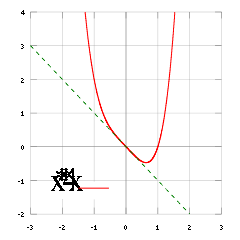Inflection point
![]()
The title of this article is ambiguous. For other meanings, see Turning point (disambiguation).
In mathematics, an inflection point is a point on a function graph at which the graph changes its curvature behavior: The graph changes here either from a right-hand curve to a left-hand curve or vice versa. This change is also called an arc change. The determination of inflection points is part of a curve discussion.
An inflection point 




If one considers the second derivative of a function 
Tangents through a turning point (drawn in red in the picture) are called turning tangents. Turning points where these turning tangents run horizontally are called saddle, terrace or horizontal turning points.
Analogous to the term extreme value, the term inflection value for the corresponding function value seems 

Turning point with turning tangent

Curvature behavior of the function sin(2x). The tangent is colored blue in convex areas, green in concave areas and red at inflection points.
Definition
Let be ![{]a,b[}\subset \mathbb{R}](https://www.alegsaonline.com/image/a7e0b2eb730f77194f71b92b704bbc7dcbd4467b.svg)
![f\colon {]a,b[}\to \mathbb {R}](https://www.alegsaonline.com/image/11d2c2898c603ff521c5682305b0fa89bedac063.svg)


![]\alpha ,x_{0}[](https://www.alegsaonline.com/image/25f9d4f71b5db53baabdb50c885f9222e2335004.svg)
![]x_{0},\beta [](https://www.alegsaonline.com/image/a973e19877c64cccf9ece3332d6ea38a8ebf5284.svg)
- is
convex
in and
concave in or that
- is
concave
in and
convex in
This means that the graph of the function changes the sign of its curvature 

Criteria for determining inflection points
In the following we assume that the function ![f\colon {]a,b[}\to \mathbb {R}](https://www.alegsaonline.com/image/11d2c2898c603ff521c5682305b0fa89bedac063.svg)

Necessary criterion
Let ![f\colon {]a,b[}\to \mathbb {R}](https://www.alegsaonline.com/image/11d2c2898c603ff521c5682305b0fa89bedac063.svg)

If 

Sufficient criterion without using the third derivative
In curve discussions, one of the following two sufficient conditions is usually used. In the first condition, only the second derivative occurs; for this, the sign of 

If 



Sufficient criterion using the third derivative
In the second condition sufficient for a turning point, the third derivative is also needed, but only at the point 

More precisely, it follows from 






Sufficient criterion using further derivations
If the function is 



This more general formulation contains with it already the preceding case: Beginning with the third derivative the next derivative different from zero is looked for, and if this is a derivative of odd order, it is a turning point.
Or formulated in general terms: If the first nonzero derivative 





For the function f(x)=x4-x, the second derivative at x=0 is zero; but (0,0) is not an inflection point because the third derivative is also zero and the fourth derivative is nonzero.
Example
Then the second derivative of the function is given by:
A turning point 

satisfy. From this follows 
From 




The 

The equation of the tangent of inflection can be determined by substituting the x-coordinate of the inflection point (2) into the first derivative. Thus one receives the gradient (m). Afterwards one puts into the function determination (y = mx + b) the determined x & y coordinate of the turning point and the m (gradient) value. Then you get the intersection with the y-axis (b) and thus the complete equation of the tangent of inflection.
Angle tangent:
Special cases
The graph of the function 


The graph of the function with the equation 




See also
- Flat point, a point at which
(or at which
but the curvature behavior does not change - depending on the definition).
Search within the encyclopedia











